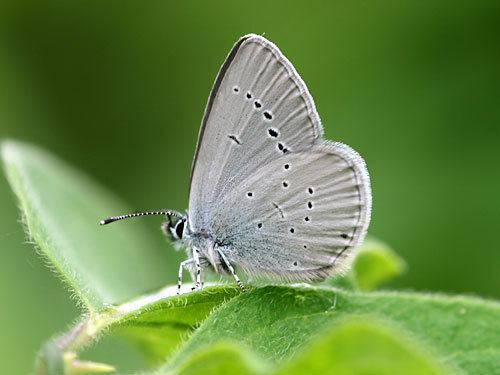Higher classification Cupido | Scientific name Cupido minimus Rank Species | |
 | ||
Similar Butterfly, Butterflies and moths, Purple hairstreak, Aricia agestis, Green hairstreak | ||
British butterflies adonis silver studded small blue etc
The small blue (Cupido minimus) is a butterfly in the family Lycaenidae. Despite its common name, it is not particularly blue. The male has some bluish suffusion at the base of its upper wings but is mostly dark brown like the female. The undersides are a silvery grey with small black dots. The male has a bluish tint at the base of its wings similar to the upper side.
Contents
- British butterflies adonis silver studded small blue etc
- Distribution
- UK and Ireland
- Habitats
- Subspecies
- Life cycle and food plants
- References
Distribution
It is found in Europe, Asia Minor, Transcaucasia, Tian-Shan, western Siberia, central Siberia, southern Siberia, the Russian Far East, Amur, Mongolia, Magadan and Kamchatka. Recorded larval food plants are Oxytropis campestris, Astragalus alpinus, Lotus corniculatus, Anthyllis vulneraria, Melilotus, Coronilla, Medicago, Anthyllis vulneraria, Astragalus glycyphyllos and Astragalus cicer.
UK and Ireland
This is Britain's smallest resident butterfly. It has a very patchy distribution across the UK with its strongholds on the chalk and limestone grasslands of southern England such as the Cotswolds and Salisbury Plain. Across the rest of Britain and Ireland it is often associated with coastal habitats with widely scattered colonies in northern England and the far north of Scotland.
Habitats
Calcareous grassland, abandoned quarries, railway and embankments and woodland edges and clearings.
Subspecies
Cupido minimus trinacriae Verity, 1919 Sicily
Life cycle and food plants
The larva feeds on several species of small legumes. Its main food plants are kidney vetch Anthyllis vulneraria - also the sole food plant in the United Kingdom - Oxytropis campestris in north-eastern Europe, Lotus corniculatus, and, in northern Scandinavia, Astragalus alpinus. Eggs are laid singly on young flower heads and the larvae feed on the flower heads and developing seeds. They are cannibalistic and will eat any smaller larvae they come across. Females will rarely lay eggs on a flower head where one is already present. The fully grown larvae are a pale cream colour and are well camouflaged as they sit on the developing seed heads. In the autumn they descend and hibernate in crevices in the ground. Pupation occurs the following spring at ground level in the leaf litter. On the continent both larvae and pupae are tended by ants but there is little evidence of this occurring in the UK. In the south of England there are two broods, one on the wing in June and a second in August but further north there is just one brood flying in June.
